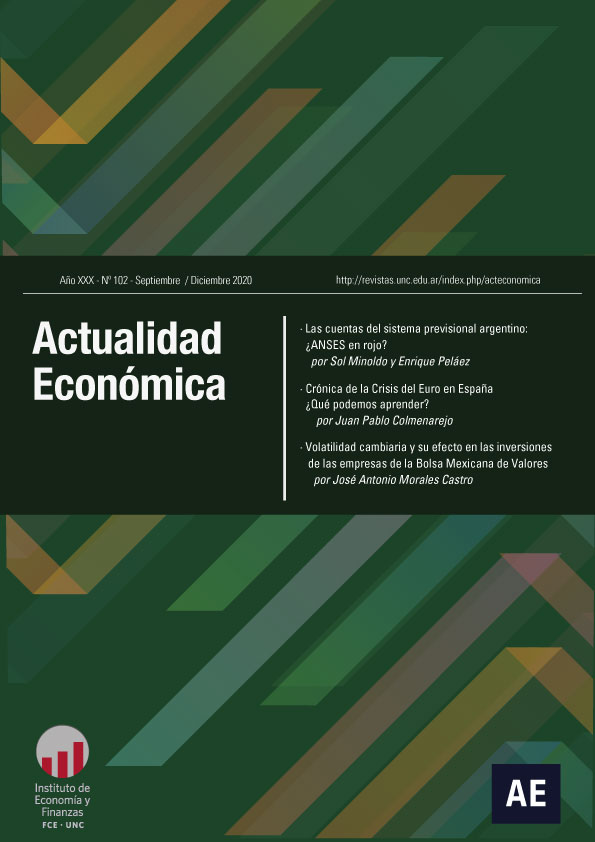The accounts of the Argentinian social security: ¿ANSES in deficit?
Keywords:
Argentina, Fiscal deficit, Social Security, SustainabilityAbstract
The main purpose of this article is to establish the explanatory weight of each factor in the financial difficulties of the pension system in Argentina, as well as to establish which are and which are, in addition to the adjustment of access and benefits, the possible measures to balance the accounts. To do this, we analytically separate the different components that explain the expansion of expenses and income. We also analyze how the interaction between the evolution of income and expenditures was politically significant in recent years, articulated in one or another discourse. We found that until 2014, the measures taken that involved the expansion of total spending had financing at their disposal. In 2014, the total resources of the ANSES reached almost to the limit of its possibilities, breaking the collaboration of the National Treasury. However, since then, measures have been taken twice to expand spending without providing for new financing. In addition, the system lost sources of financing that were compensated by contributions from the Treasury. This implied a new factor of vulnerability in the sustainability of social security.
Downloads
References
ANSES (2019a). “Esquema Ahorro Inversión Financiamiento (2010 - 2016)”. [23-3-2018]. Disponible en web: https://www.ANSES.gob.ar/institucional/datos-abiertos/financiero/.
ANSES (2019b). “Boletín Estadístico de la Seguridad Social (BESS), primer trimestre 2019”. [21-5-2020] Disponible en web: https://www.argentina.gob.ar/sites/default/files/estadisticas_de_seguridad_social_i_trimestre_2019_0.xlsx
ANSES (2018). “Asignaciones familiares”. [23-3-2018] Disponible en web: https://www.anses.gob.ar/institucional/datos-abiertos/
ANSES (2018b). “Boletín Estadístico de la Seguridad Social (BESS), Segundo trimestre 2018”. [23-3-2019] Disponible en web: https://www.argentina.gob.ar/sites/default/files/01.bess_2otrim_2018_0.pdf
Bertranou F. y Bonari D. (2005). Protección social en Argentina: financiamiento, cobertura y desempeño 1990-2003. Santiago de Chile: Oficina Internacional del Trabajo.
Danani C. y Hintze S. (Eds.) (2014). Protecciones y desprotecciones (II). Problemas y debates de la seguridad social en la Argentina, 1990-2010. Universidad Nacional de General Sarmiento.
DPEyC-San Luis (2018). IPC SAN LUIS. [23-3-2019] Disponible en web: http://admin.estadistica.sanluis.gov.ar/estadisticaasp/Paginas/Pagina.asp?PaginaId=76
INDEC (2018). Microdatos de EPH. [23-3-2019] Disponible en web: https://www.indec.gov.ar/bases-de-datos.asp.
Infoleg (2018). Leyes nº 23.848, 23.966, 24.013, 24.130, 24.241, 24.465, 24.625, 24.674, 24.698, 24.699, 24.977, 25.013, 25.239, 25.250, 25.453, 25.723, 25.877, 25.994, 26.078, 26.222, 26.425, 26.476, 26.658, 26.940, 27.260, 27.426, 27.429, 27.430, 27.431, 27.432. [23-3-2019] Disponible en web: http://www.infoleg.gob.ar/?page_id=112
La Nación (2018). “El impuesto al cheque y un decreto pendiente para aliviarlo”. [23-3-2019] Disponible en web: https://www.lanacion.com.ar/2108149-el-impuesto-al-cheque-y-un-decreto-pendiente-para-aliviarlo
La Política Online (2017). Macri a los gobernadores: “La ANSES no aguanta más". [23-3-2019] Disponible en web: http://www.lapoliticaonline.com/nota/109486/.
MECON (Ministerio de Economía de la Nación) (2020). Recursos Tributarios de Origen Nacional - Información Consolidada. [20-5-2020] Disponible en web: https://www.minhacienda.gob.ar/dnap/recursos.html
Naciones Unidas (2017). Annual Population by Age - Both Sexes, en United Nations: World population prospects, the 2017 Revision. Monitoring global population trends. United Nations, Department of economic and social affairs, Population Division. New York. [23-3-2019] Disponible en web: https://esa.un.org/unpd/wpp/Download/Standard/Interpolated/.
OSS (Observatorio de Seguridad Social) (2011). Análisis de la cobertura previsional del SIPA: protección, inclusión e igualdad. Buenos Aires. [23-3-2019] Disponible en web: http://observatorio.anses.gob.ar/archivos/documentos/An%C3%A1lisis%20de%20la%20Cobertura%20del%20SIPA.pdf
OEDE (Observatorio de Empleo y Dinámica Empresarial) (2018a). “Evolución de las remuneraciones de los trabajadores registrados. Serie mensual”. Estadísticas publicadas por el Observatorio de Empleo y Dinámica Empresarial (OEDE), del MTEySS, a partir de datos aportados por el Sistema Integrado de Jubilaciones y Pensiones (SIPA).
OEDE (2018b). “Caracterización y evolución del empleo registrado. Serie trimestral”. Estadísticas publicadas por el Observatorio de Empleo y Dinámica Empresarial (OEDE), del MTEySS, a partir de datos aportados por el Sistema Integrado de Jubilaciones y Pensiones (SIPA).
OIT (2011). Encrucijadas en la seguridad social argentina: reformas, cobertura y desafíos para el sistema de pensiones. OIT-CEPAL. Buenos Aires. [23-3-2019] Disponible en web: https://www.ilo.org/wcmsp5/groups/public/---ed_protect/---soc_sec/documents/publication/wcms_secsoc_29187.pdf
Downloads
Published
Issue
Section
License

This work is licensed under a Creative Commons Attribution-NonCommercial-NoDerivatives 4.0 International License.
Those authors who have published with this journal, accept the following terms:
Authors will conserve their copyright and guarantee the magazine the right of first publication of their work, which will be simultaneously subject to the Creative Commons Attribution-NonCommercial-NoDerivative 4.0 International License that allows third parties to share the work as long as the author and first publication of this magazine are indicated.
Authors may adopt other non-exclusive license agreements to distribute the published version of the work (e.g., deposit it in an institutional telematic archive or publish it in a monographic volume) provided that the initial publication in this journal is indicated.
Authors are allowed and encouraged to disseminate their work through the Internet (e.g., in institutional telematic archives or on their website) before and during the submission process, which may lead to interesting exchanges and increase citations of the published work. (See The effect of open access)









